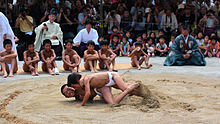Kamigamo Shrine
| Kamigamo Shrine 上賀茂神社 | |
|---|---|
 | |
| Religion | |
| Affiliation | Shinto |
| Deity | Kamowakeikazuchinomikoto |
| Festival | Aoi Matsuri (Kamo no Matsuri; May 15th) |
| Type | Shikinaisya Twenty-Two Shrines Yamashiro no Kuni ichinomiya Former kanpeitaisha Chokusaisha Beppyo jinja |
| Location | |
| Location | 339 Kamigamomotoyama, Kita-ku, Kyoto, Kyoto Prefecture |
| Geographic coordinates | 35°03′37″N 135°45′10″E / 35.06028°N 135.75278°E |
| Architecture | |
| Architectural style | Sangensya-Nagare-zukuri |
| Date established | 678 |
| Website | |
| www | |
Kamigamo Shrine (上賀茂神社, Kamigamo Jinja), is a significant Shinto shrine located on the banks of the Kamo River in northern Kyoto. It was established in the year 678[1] and is formally called the Kamo-wakeikazuchi Shrine (賀茂別雷神社, Kamo-wakeikazuchi jinja)[2]Kamigamo Shrine is one of the oldest Shinto shrines in Japan and is considered a significant historical site. It is one of the seventeen landmarks in ancient Kyoto that has been recognized as a World Heritage Site by UNESCO. In Japanese, the term "Kamo-jinja" refers to both Shimogamo Shrine and Kamigamo Shrine, which are traditionally linked Kamo shrines in Kyoto.[3] These shrines have the important role of protecting Kyoto from negative influences.[4]
The shrine name is given to identify the Kamo family of deities that are worshipped at Kamigamo Shrine. The name also refers to the surrounding woods, which are remnants of the original forest of Tadasu no Mori. Moreover, the shrine's name is a tribute to the Kamo clan, who were the early inhabitants of the area where the shrine is located. Many members of the Kamo clan still live near the shrine and continue to serve the deities that their ancestors had traditionally worshipped.[5]
Kamogamo Shrine is dedicated to the veneration of Kamo Wake-ikazuchi, the kami of thunder.
History[change | change source]


During the early Heian period, Kamogamo Shrine gained the support and patronage of the Imperial family..[6]
Historical records from the reign of Emperor Heizei (806-809) show that Kamogamo Shrine was one of the few establishments that received a divine seal from the Emperor for use on important documents. The seal was enshrined in its own mikoshi, which was called the Oshite jinja. This practice of granting a special seal and its associated customs of preservation and use were established during the reign of Emperor Kōnin (770-781) in 778, according to historical records.).[7]
In 965, Emperor Murakami issued an order that Imperial messengers were to be dispatched to inform Japan's guardian kami, including Kamo Wake-ikazuchi, of significant events..[8]
Kamigamo Shrine, along with Shimogamo Shrine, was selected as one of the two primary Shinto shrines (ichinomiya) for the former Yamashiro province..[9]From 1871 to 1946, Kamigamo Shrine was recognized as one of the Kanpei-taisha (官幣大社), which means it was a government-supported shrine that held a significant position as one of the highest-ranked shrines in Japan.[10]
Imperial visits[change | change source]
- 794 (Enryaku 13): Emperor Kanmu came as part of a grand progress.[11]
- 942 (Tengyō 5, 29th day of the 4th month): Emperor Suzaku visited to offer thanks for restoration of peace.[11][11]
- 979 (Tengen 2, 10th day of the 10th month): Emperor En'yū decided that an Imperial visit Hachiman at Iwashimizu Shrine should be paired with a visit to Kamo.[12]
- 1711 (Hōei 8): Emperor Nakamikado took refuge in the Hosodono when the palace had become uninhabitable.[13]
Structures[change | change source]
The shrine is famous for its haiden (worship hall) which was rebuilt in 1628-1629
Several residences for priests are located within the grounds of Kamigamo Shrine. One of these residences, the Nishimura House, is accessible to the general public.
Gallery[change | change source]
-
Geheiden
-
Nara-no-ogawa
-
Kita-shinsenjo
-
Tatesuna & Saiden
-
Hashiden
-
Vestige of primeval forest
Related pages[change | change source]
References[change | change source]
- ↑ Kyoto Prefectural Government Tourism Division: Kamigamo Archived 2009-08-28 at the Wayback Machine; Iwao, Seiichi et al. (2002). Dictionnaire historique du Japon, p. 1712.
- ↑ Richard, Ponsonby-Fane. (1964) Visiting Famous Shrines in Japan, pp. 119-175.
- ↑ Terry, Philip. (1914). Terry's Japanese empire, p. 479.
- ↑ Miyazaki, Makoto. "Lens on Japan: Defending Heiankyo from Demons," Archived 2011-03-21 at the Wayback Machine Daily Yomiuri. December 20, 2005.
- ↑ Nelson, John K. (2000). Enduring Identities: The Guise of Shinto in Contemporary Japan, pp. 92-99.
- ↑ Breen, John et al. (2000). Shinto in History: Ways of the Kami, pp. 74–75.
- ↑ Ponsonby-Fane, Richard. (1963). The Vicissitudes of Shinto, p. 206.
- ↑ Ponsonby-Fane. Studies in Shinto and Shrines, pp. 116–117.
- ↑ "Nationwide List of Ichinomiya", p. 1. Archived 2013-05-17 at the Wayback Machine; retrieved 2011-08-010
- ↑ Ponsonby-Fane, Richard. (1959). The Imperial House of Japan, p. 124.
- ↑ 11.0 11.1 11.2 Ponsonby-Fane, Richard. (1964). Visiting Famous Shrines of Japan, pp. 47, 131.
- ↑ Ponsonby-Fane, Visiting, pp. 48, 131.
- ↑ Ponsonby-Fane, Visiting, p. 132.
Other websites[change | change source]
- Kamigamo Shrine website Archived 2017-10-23 at the Wayback Machine








